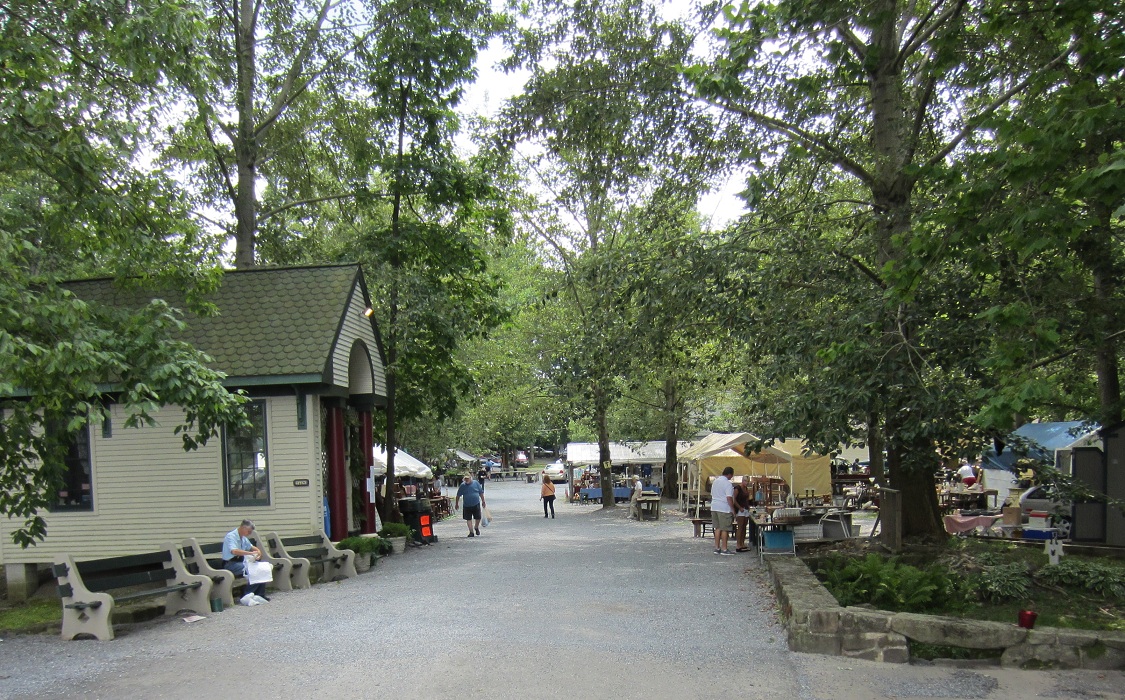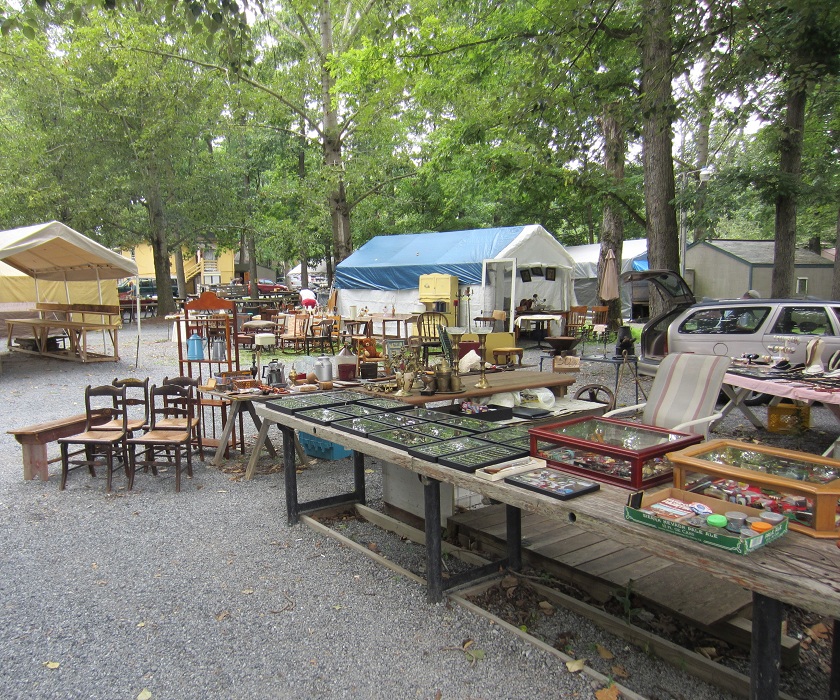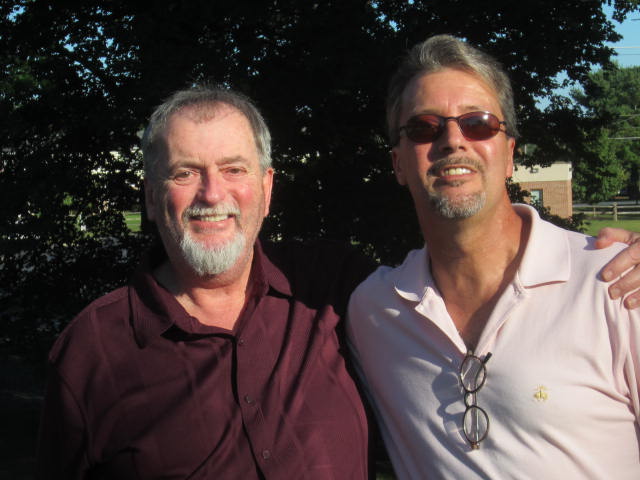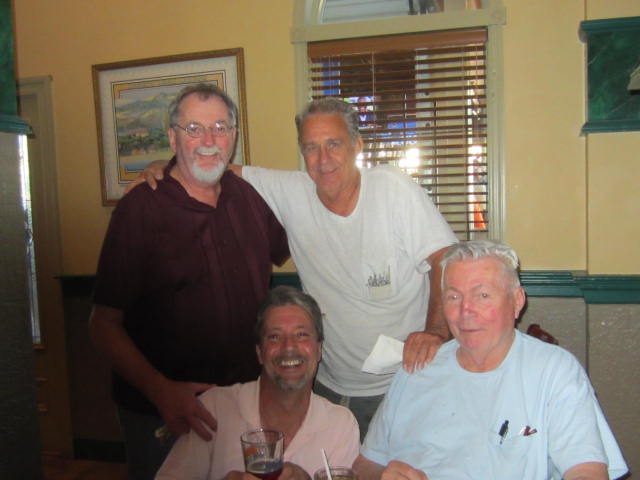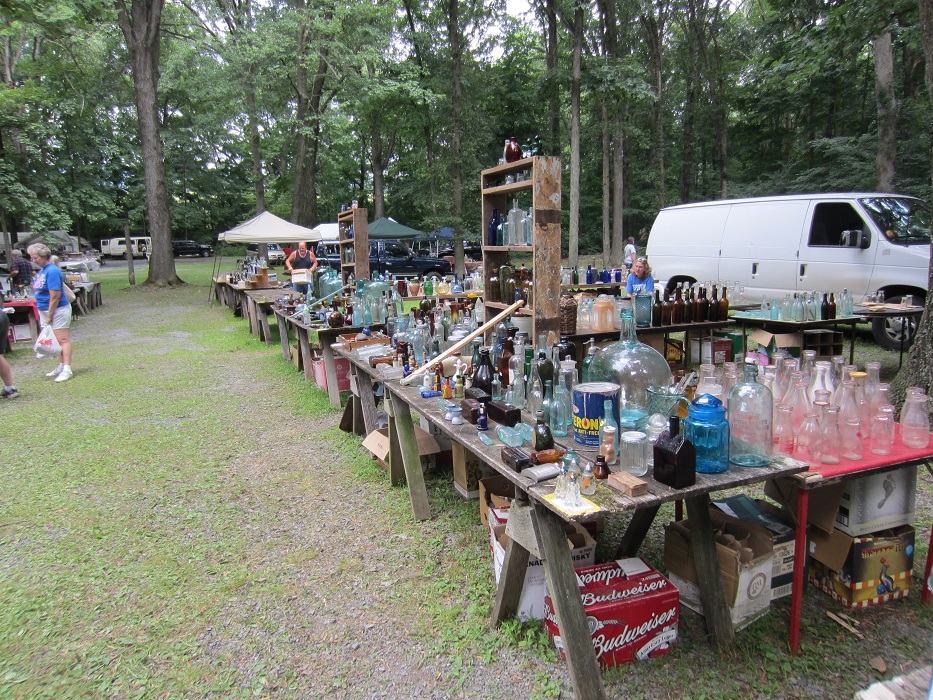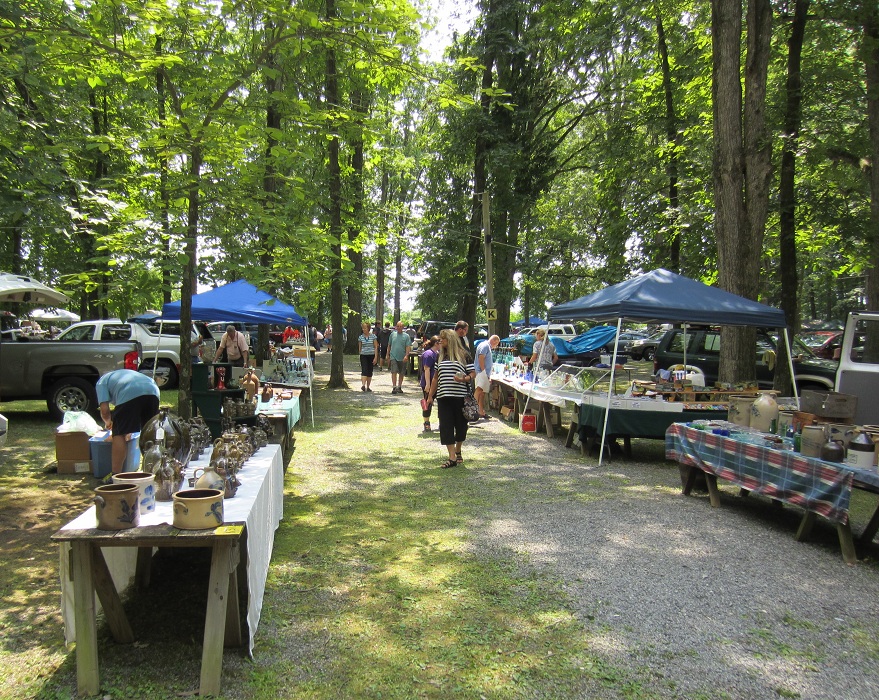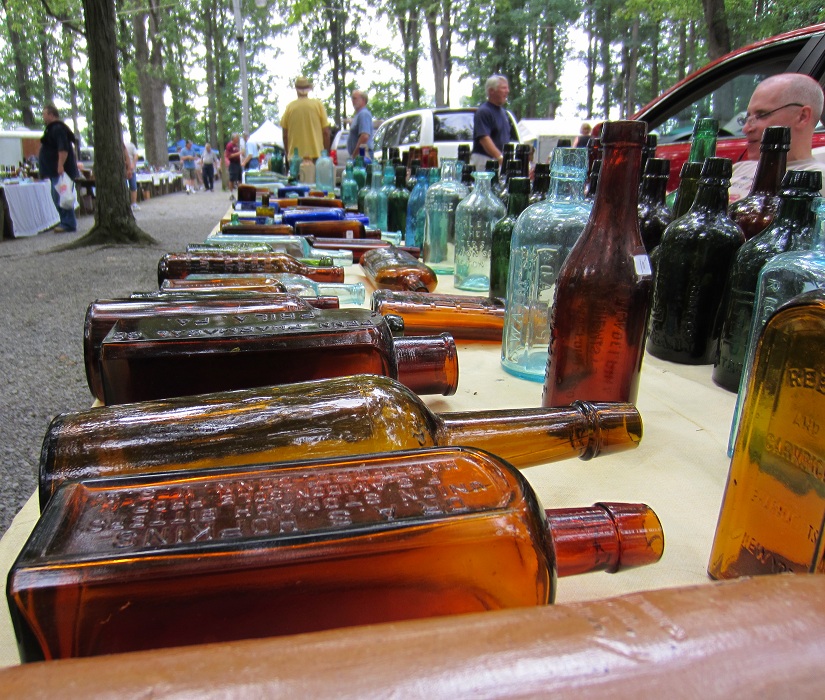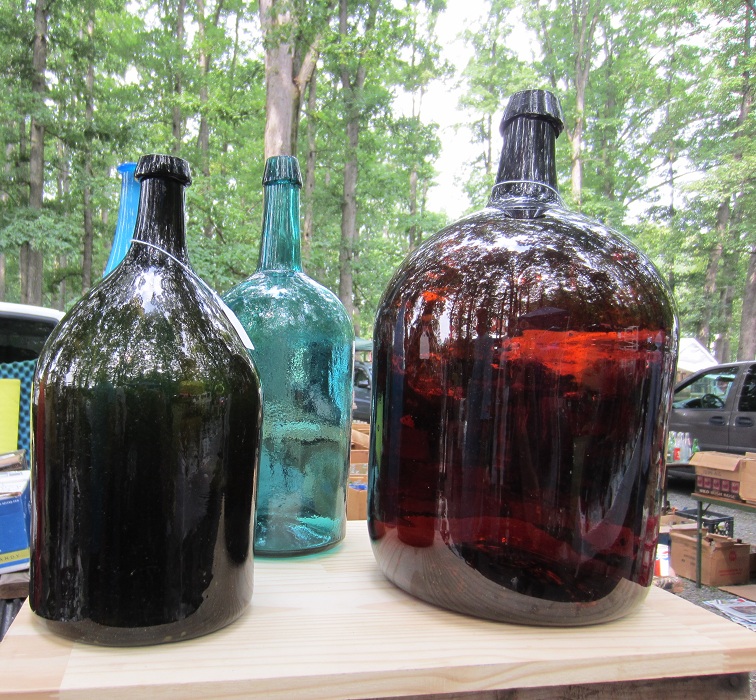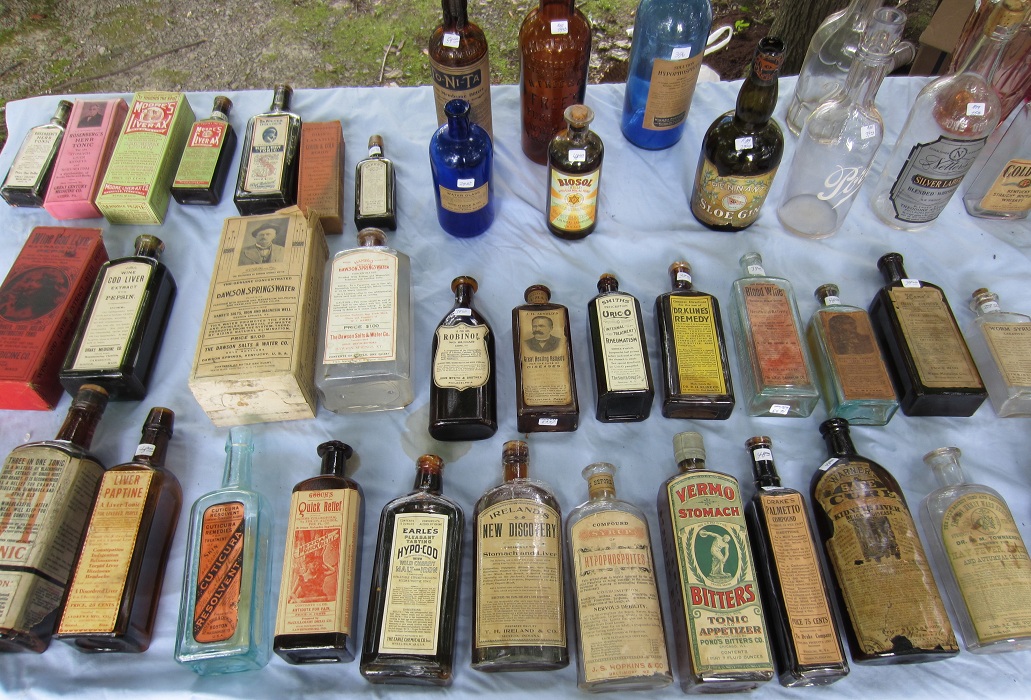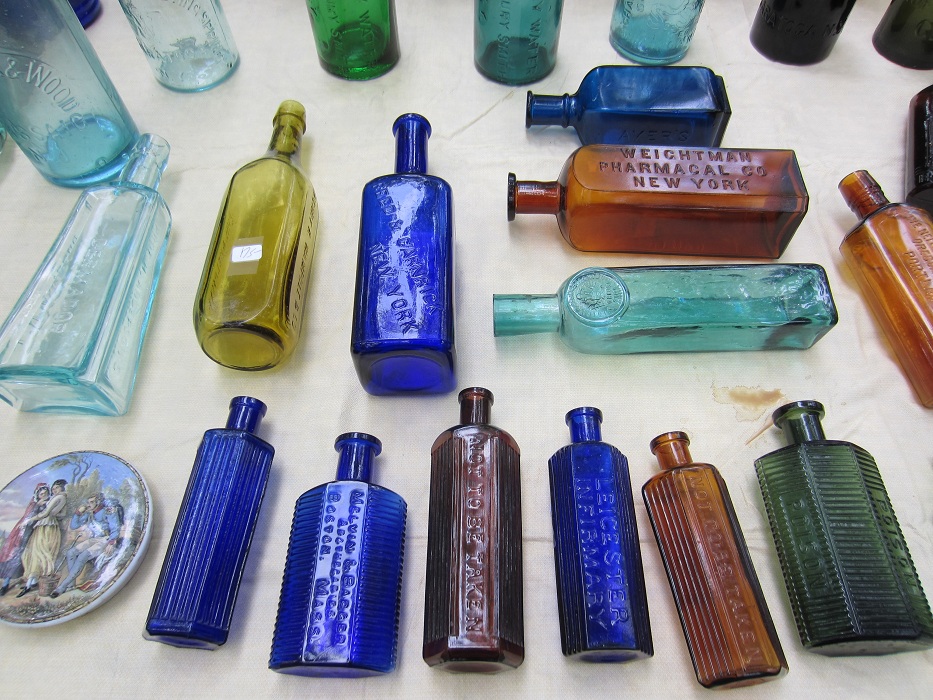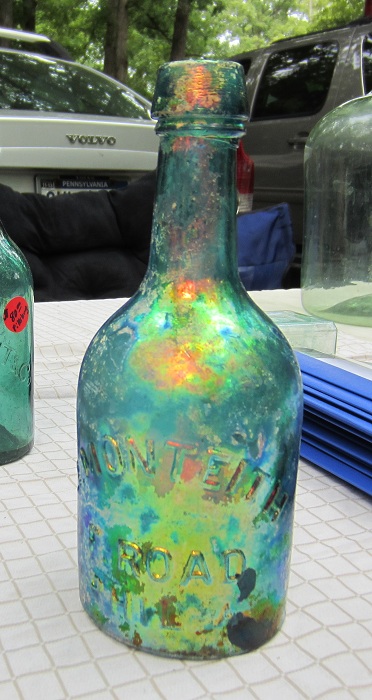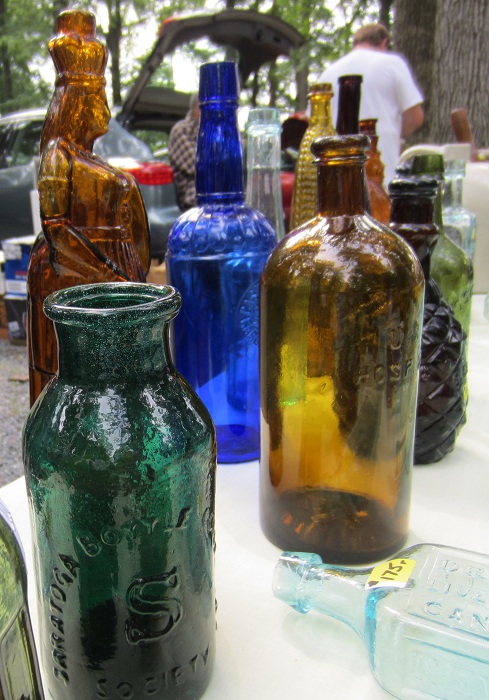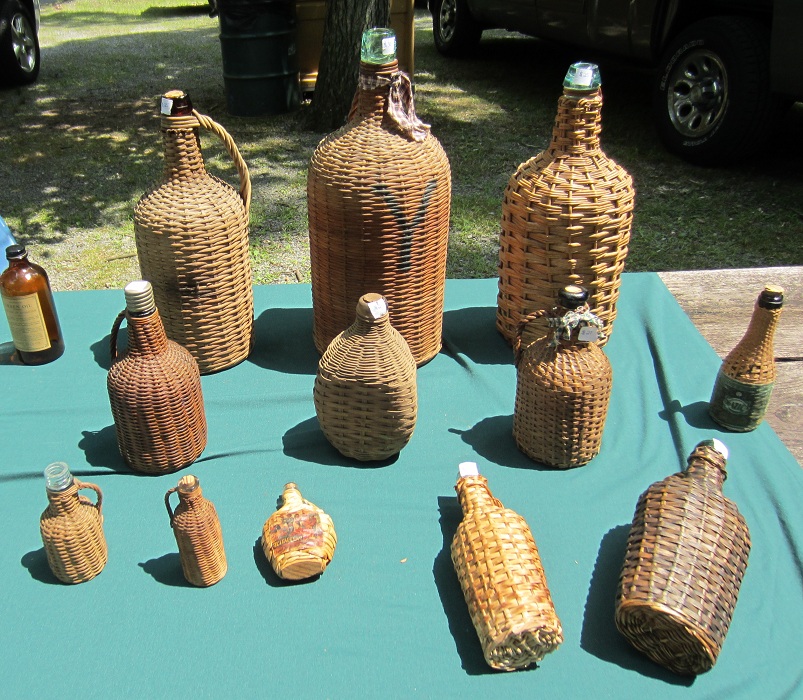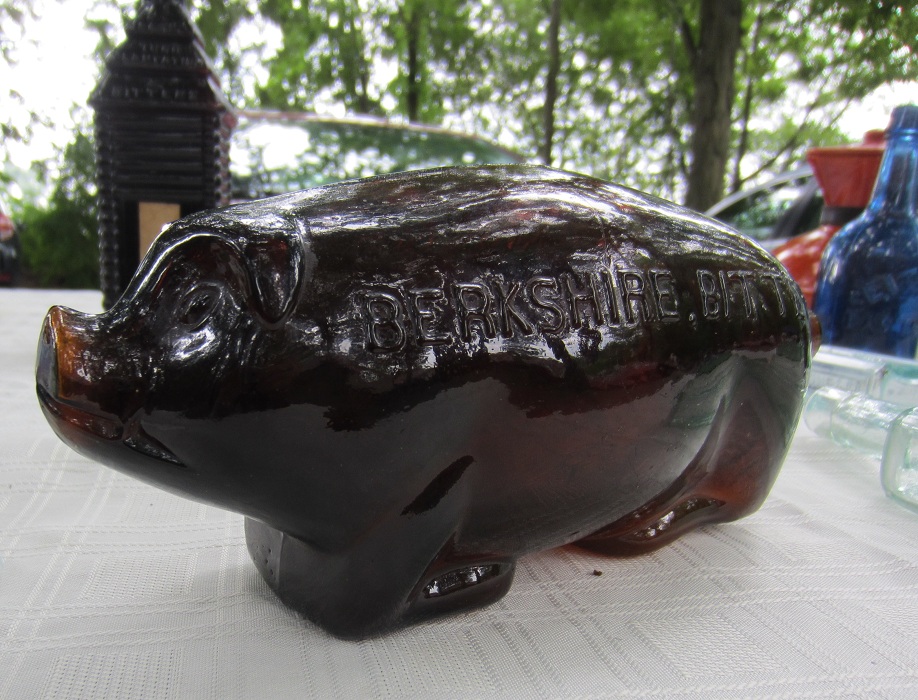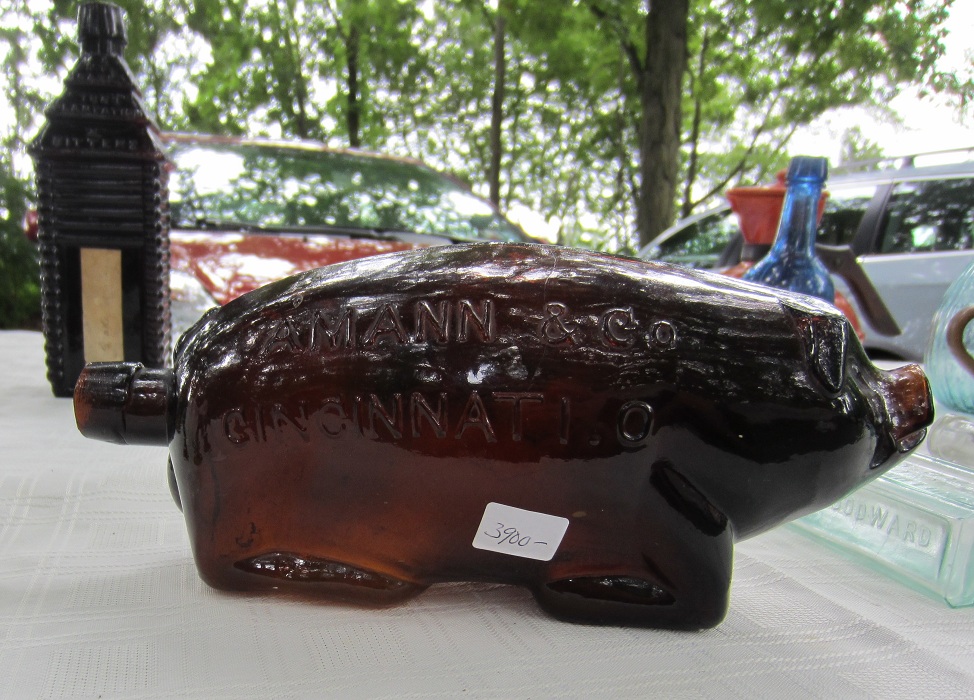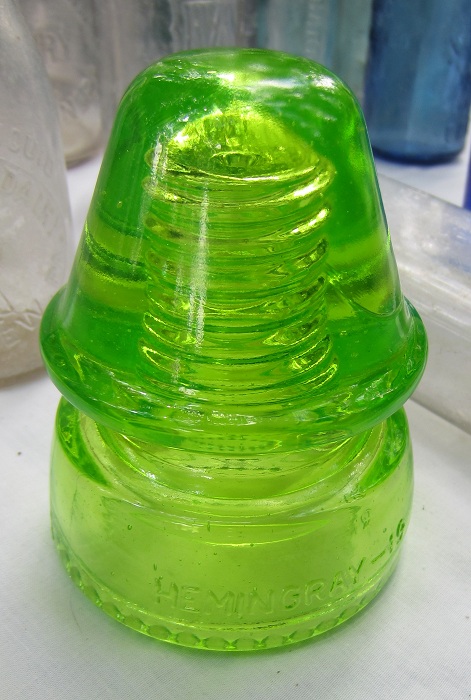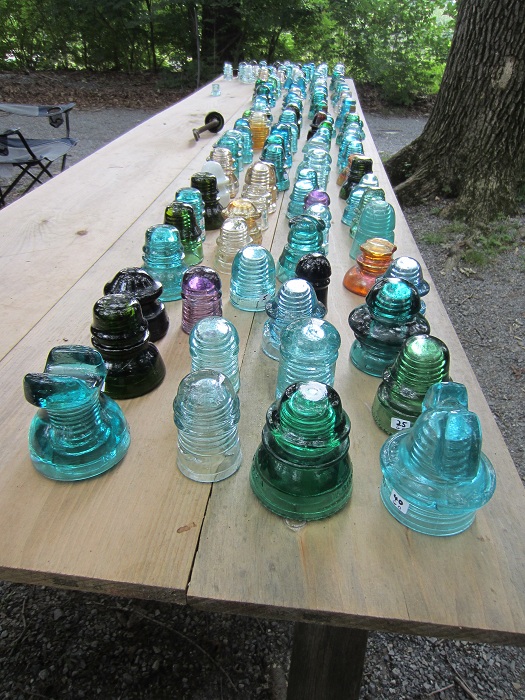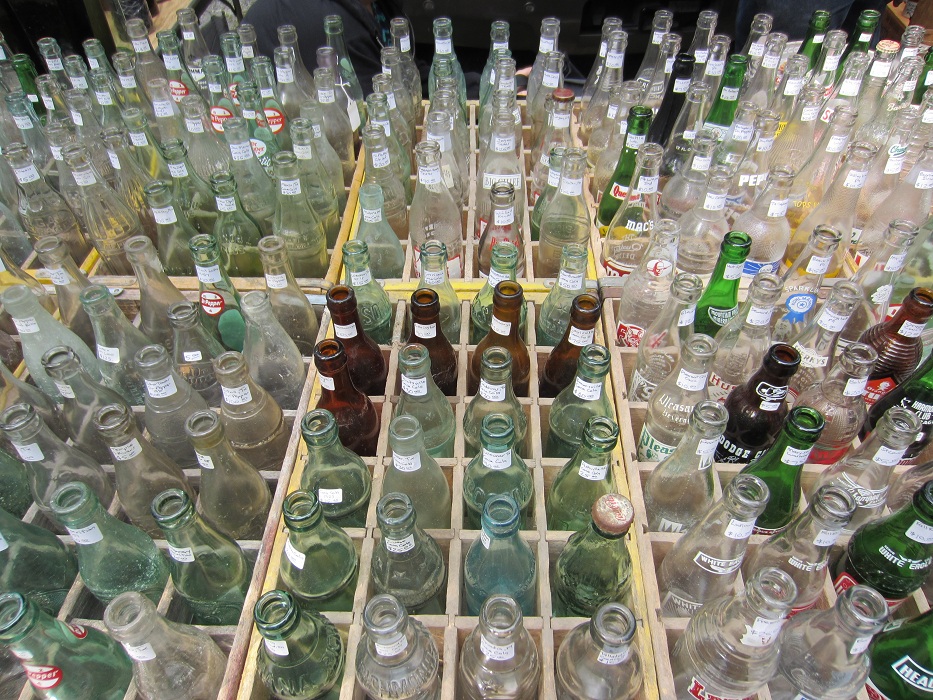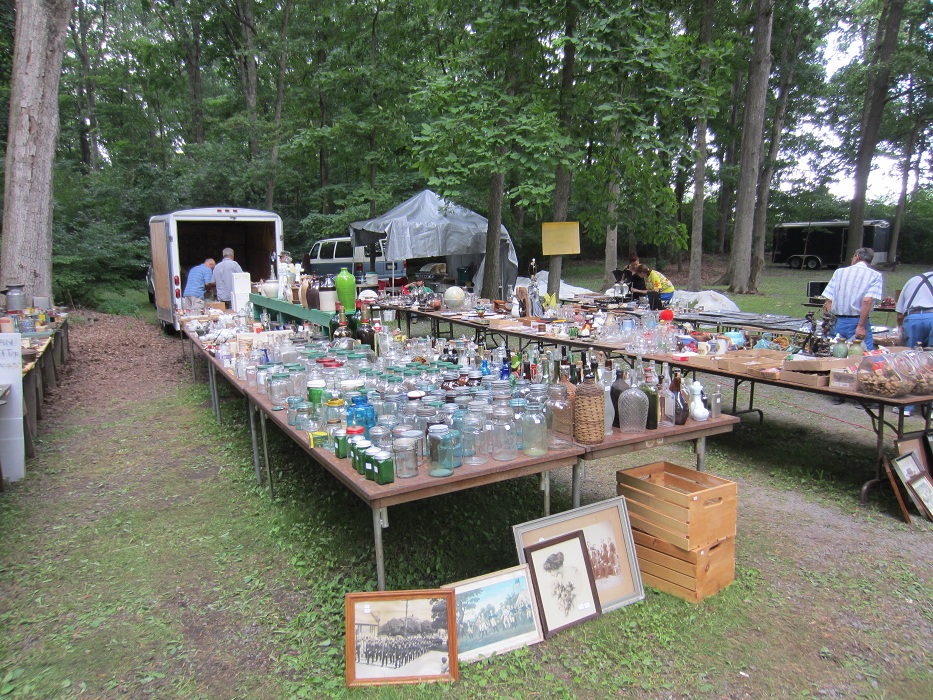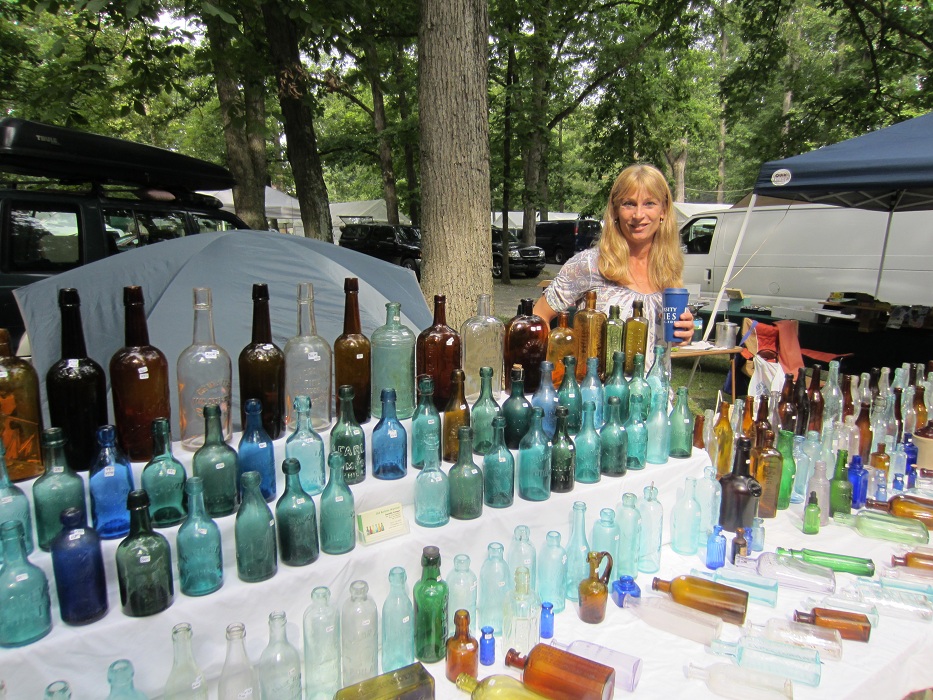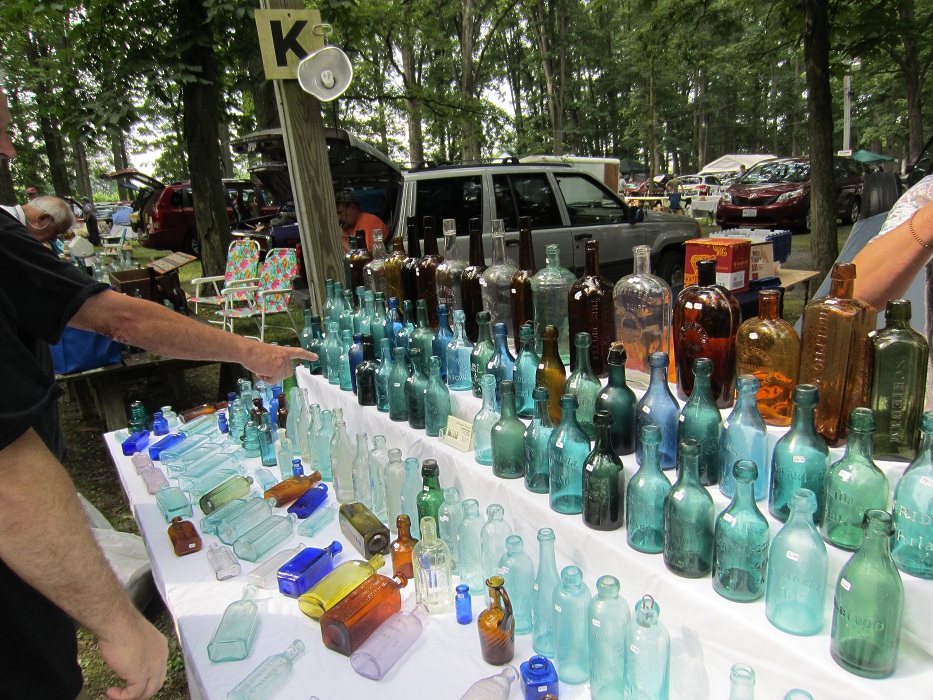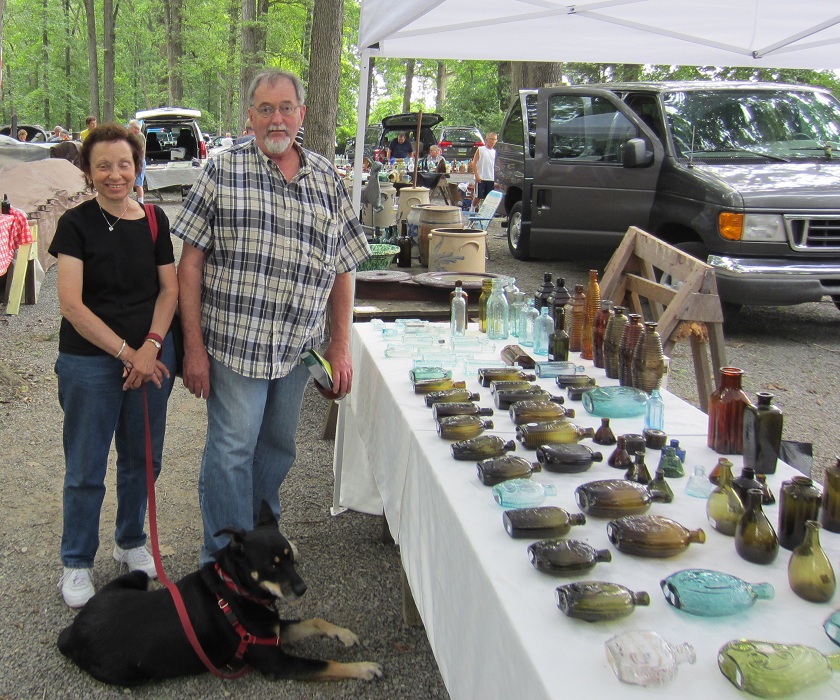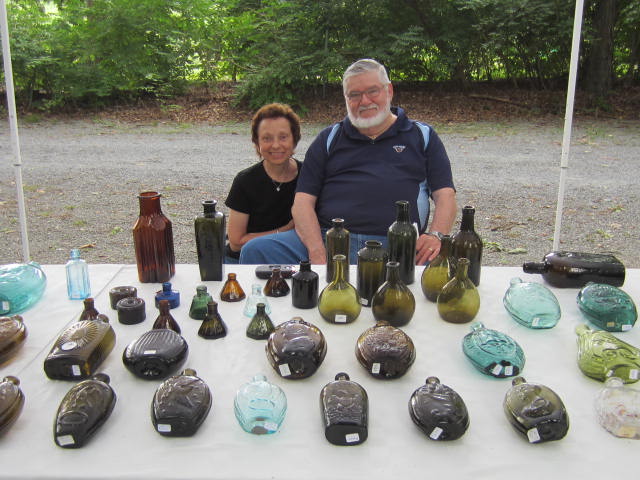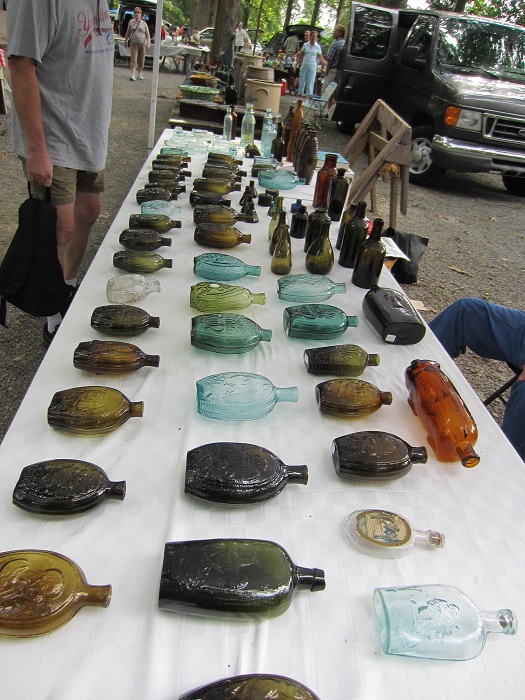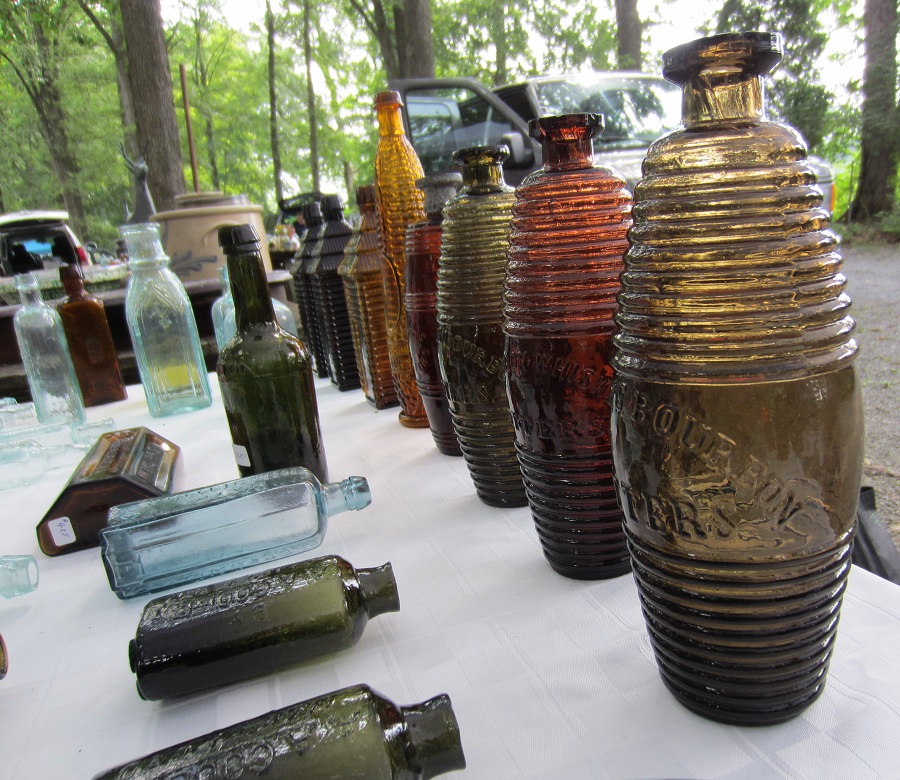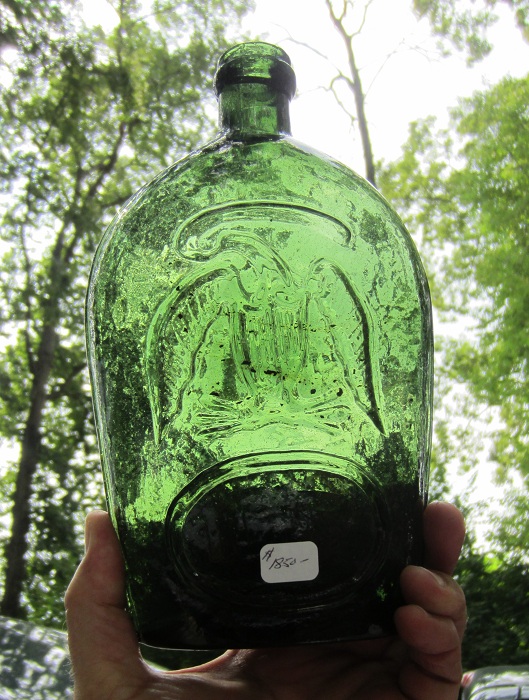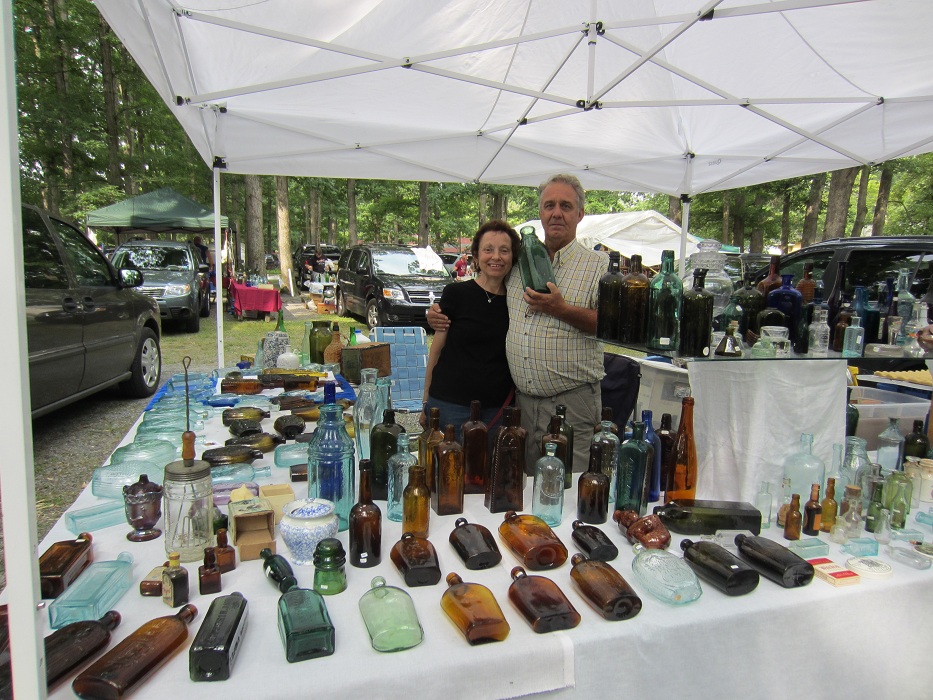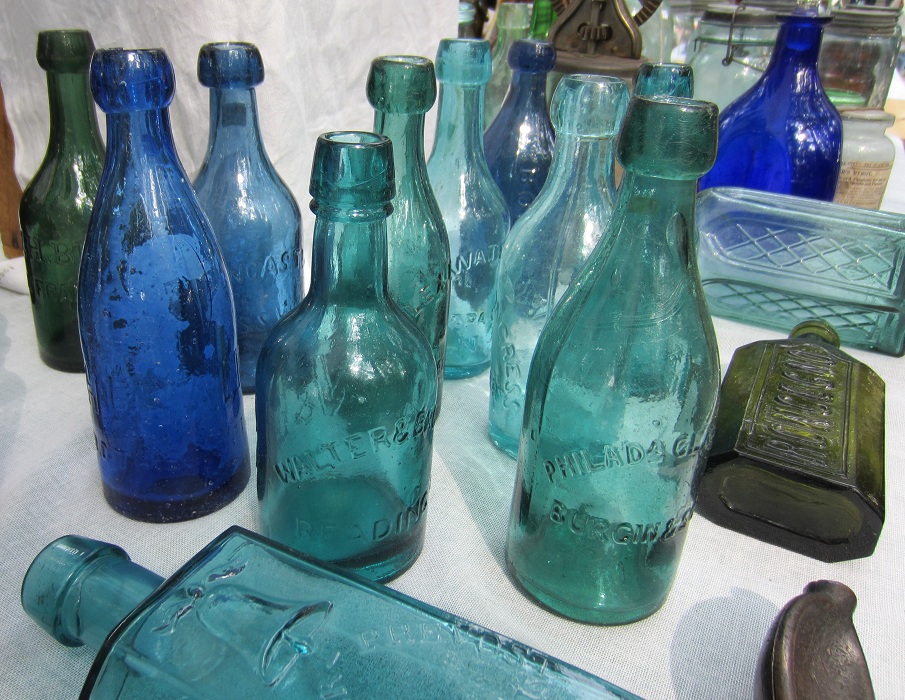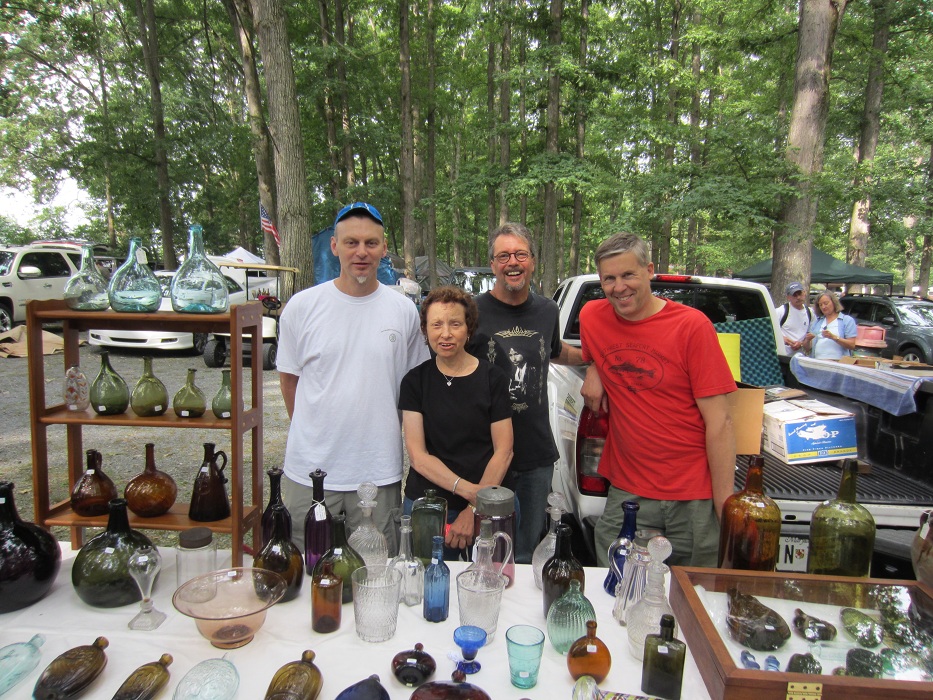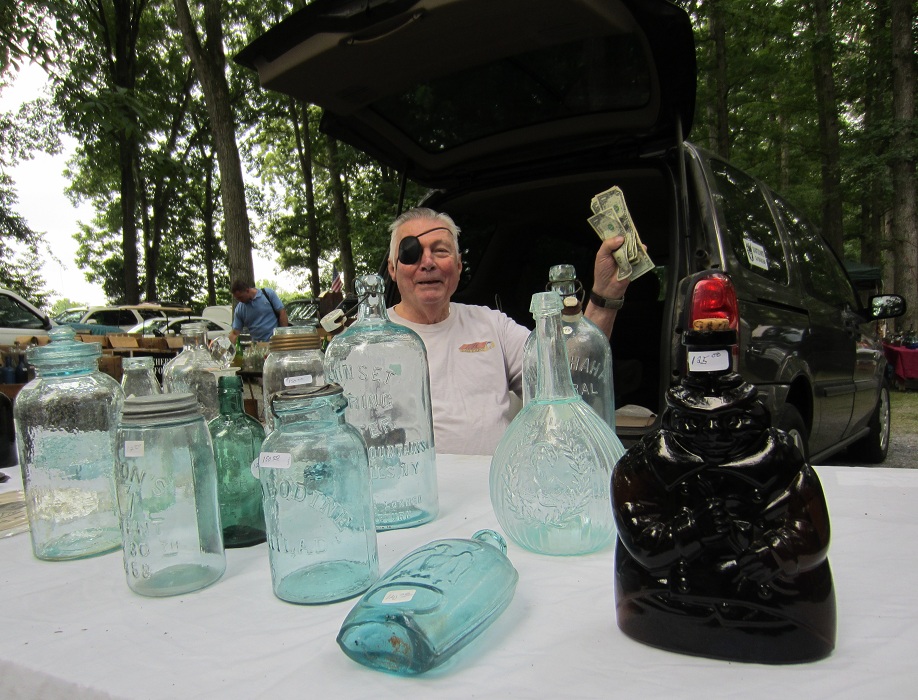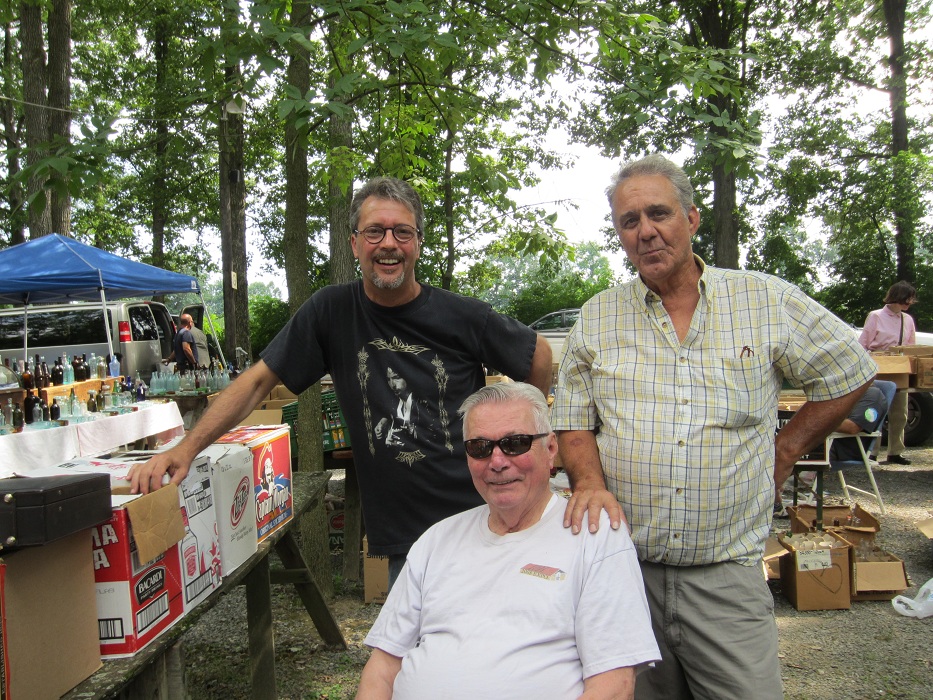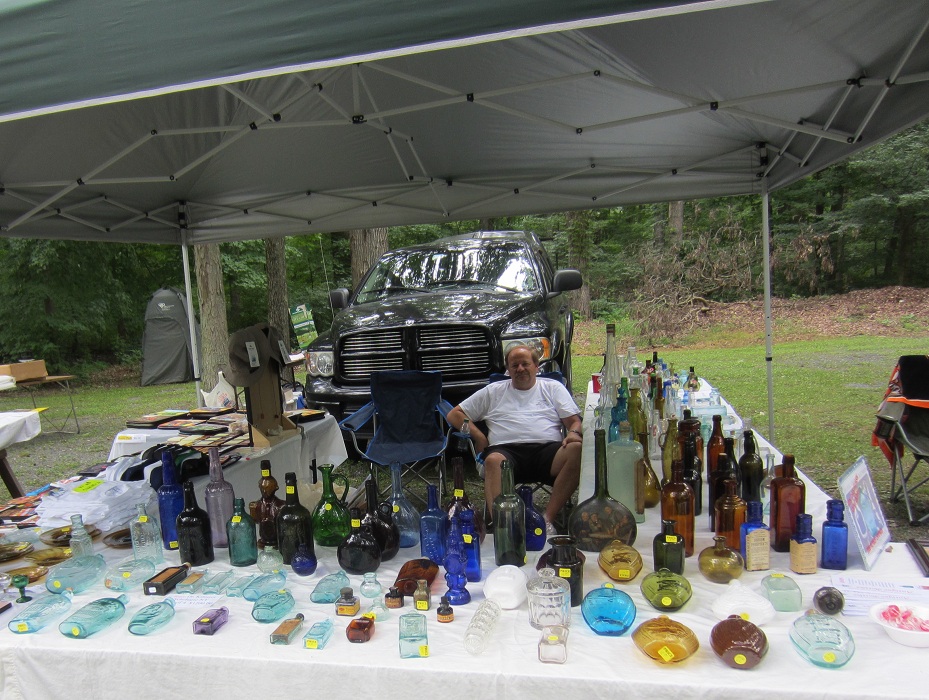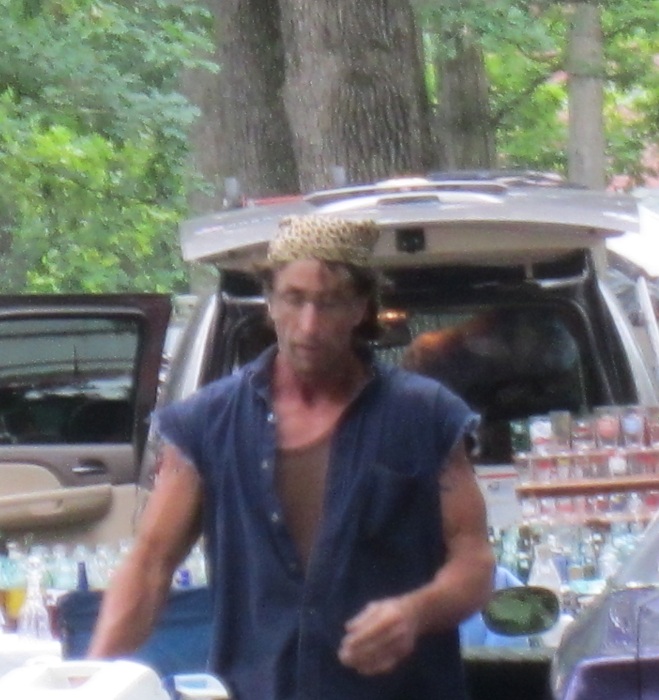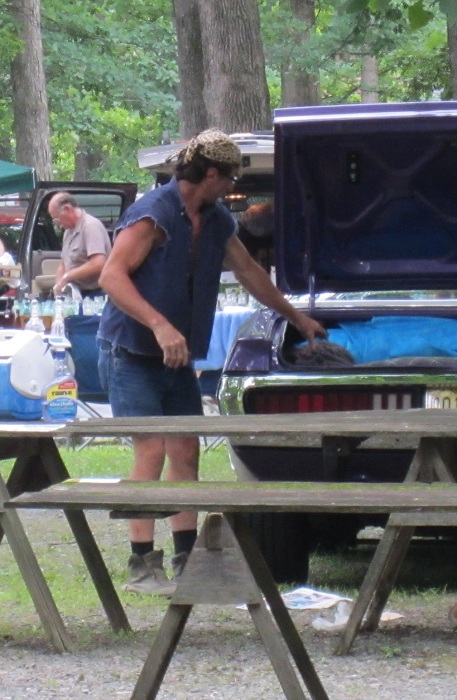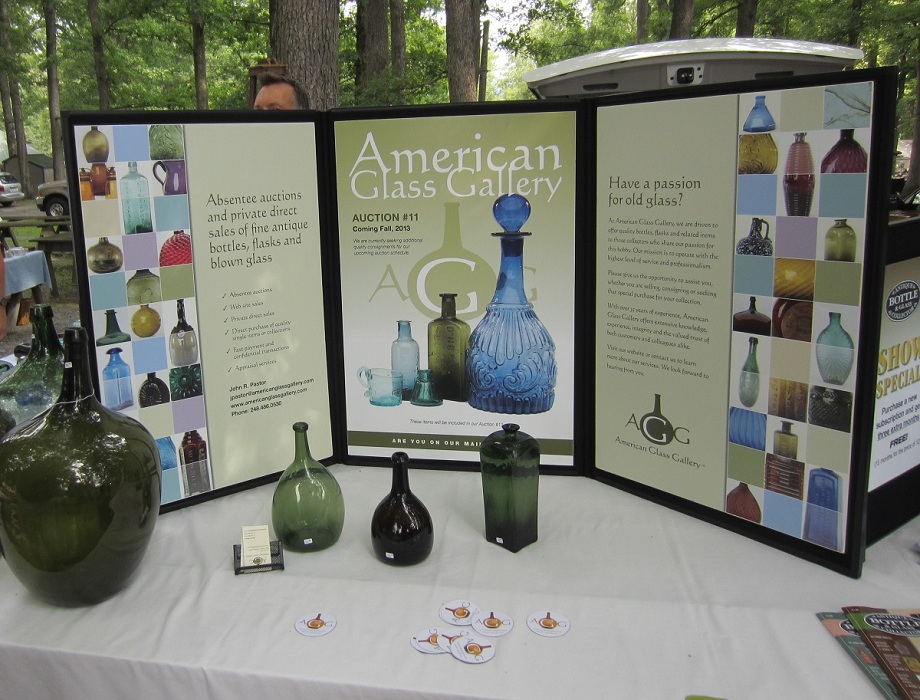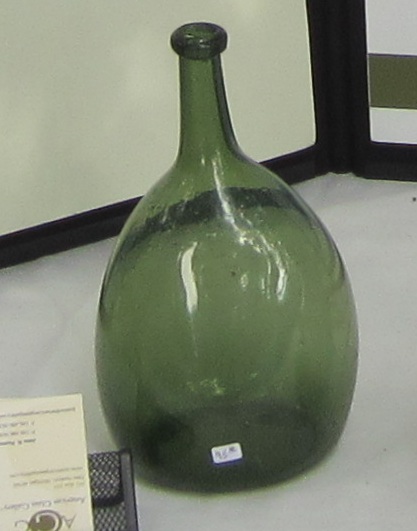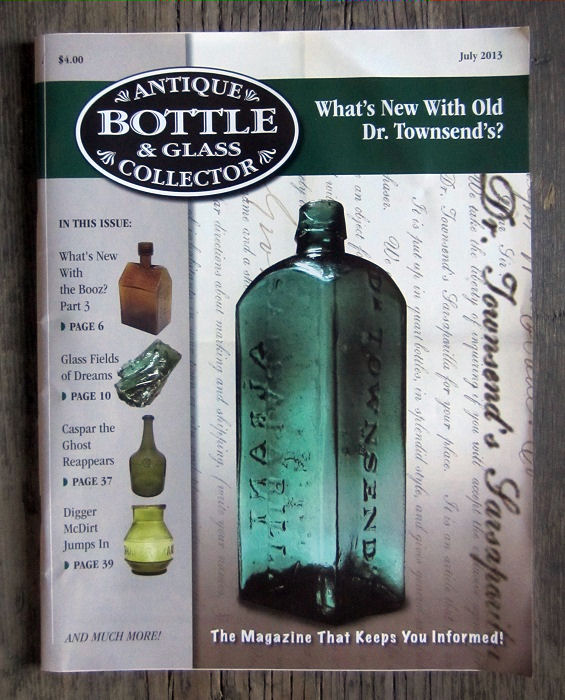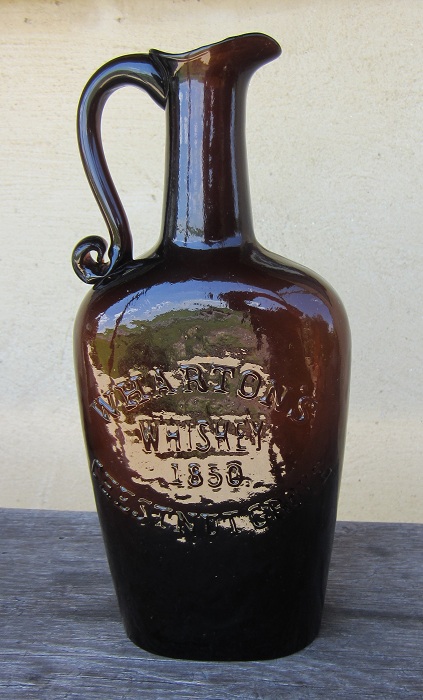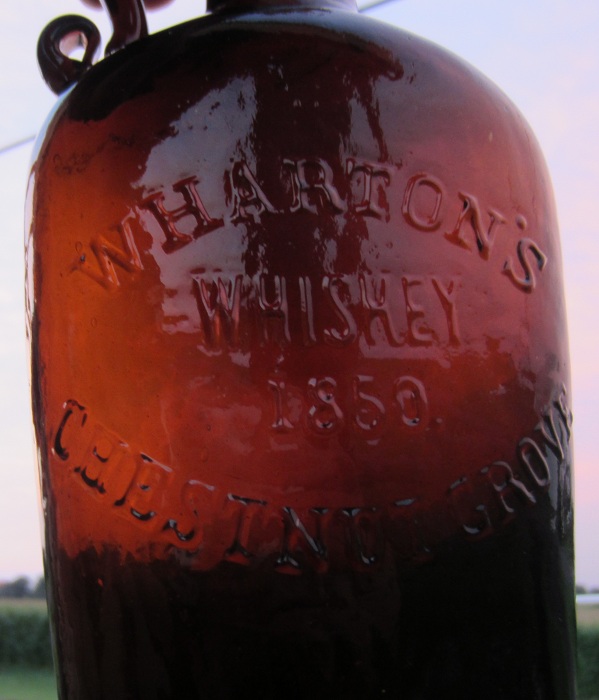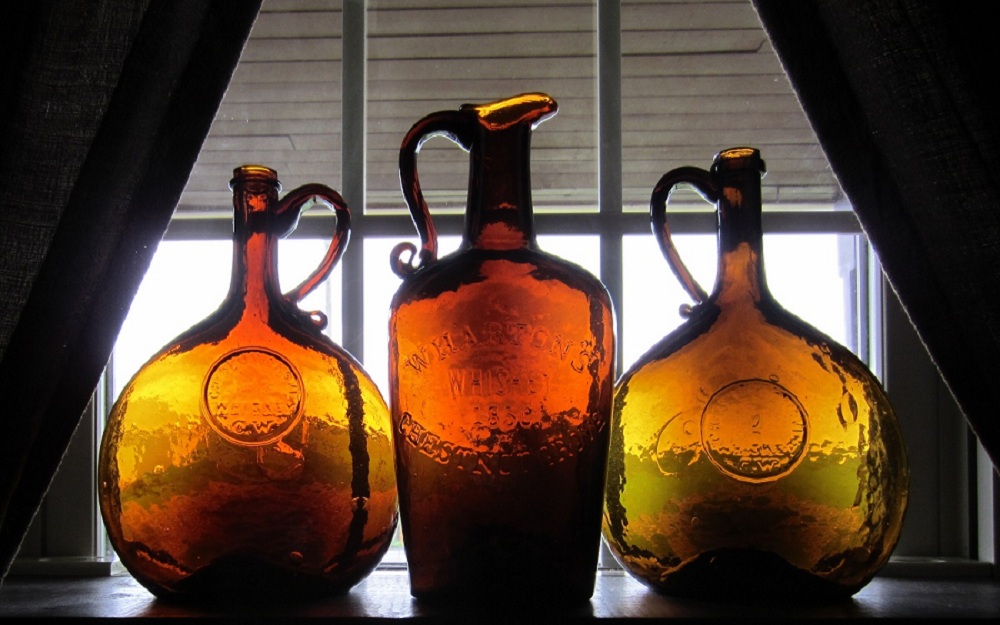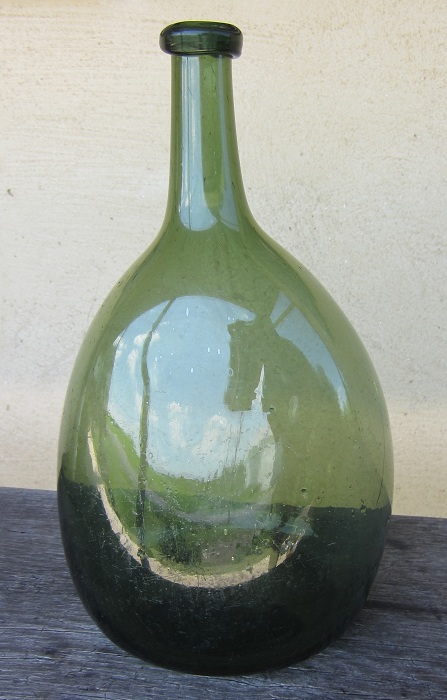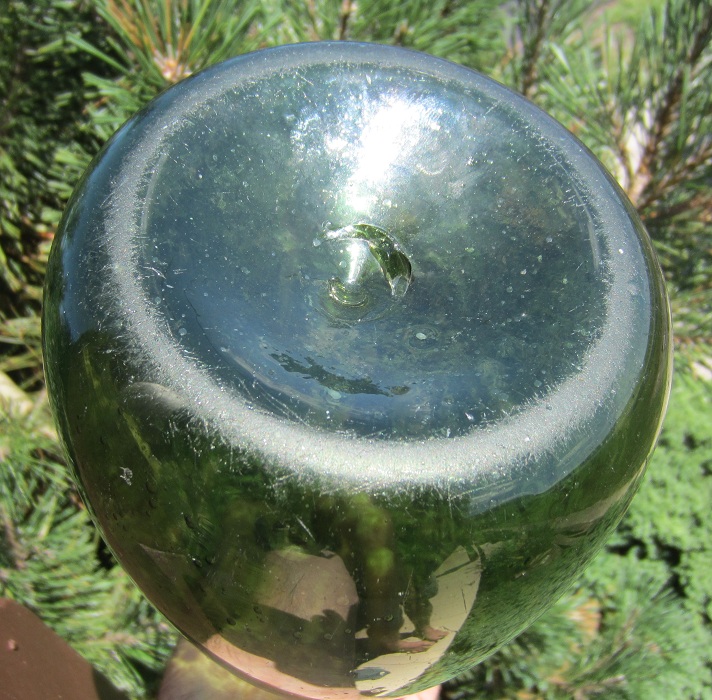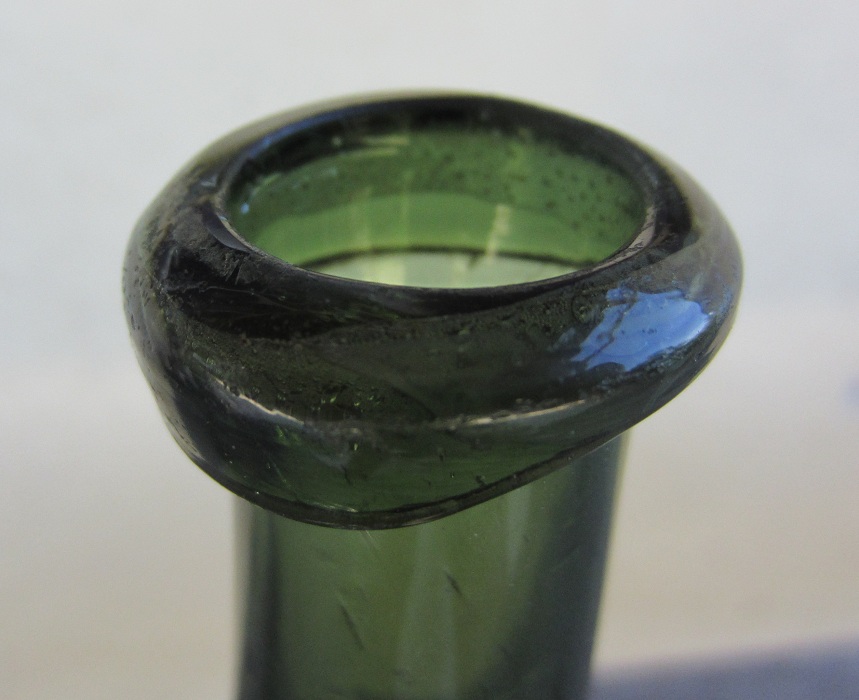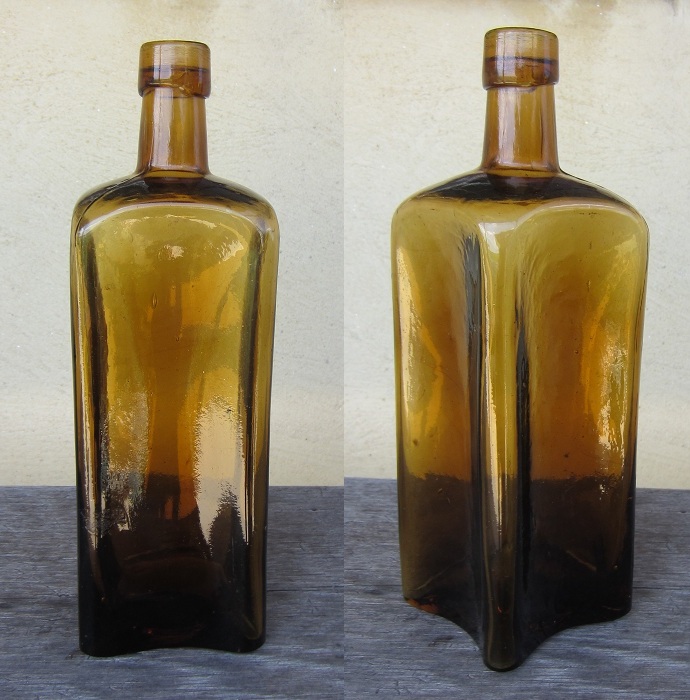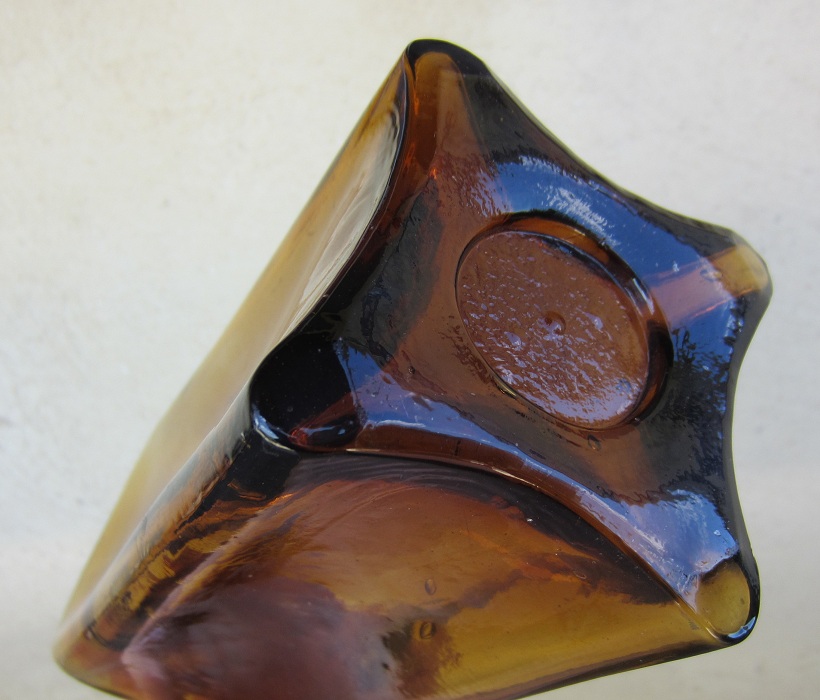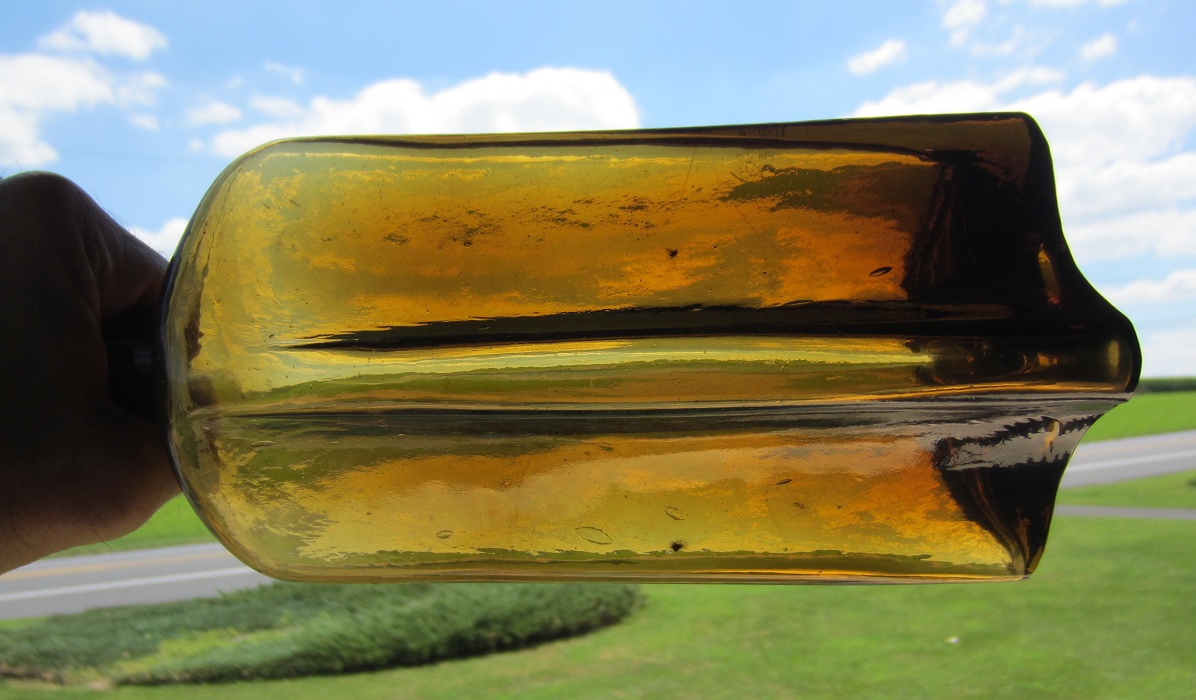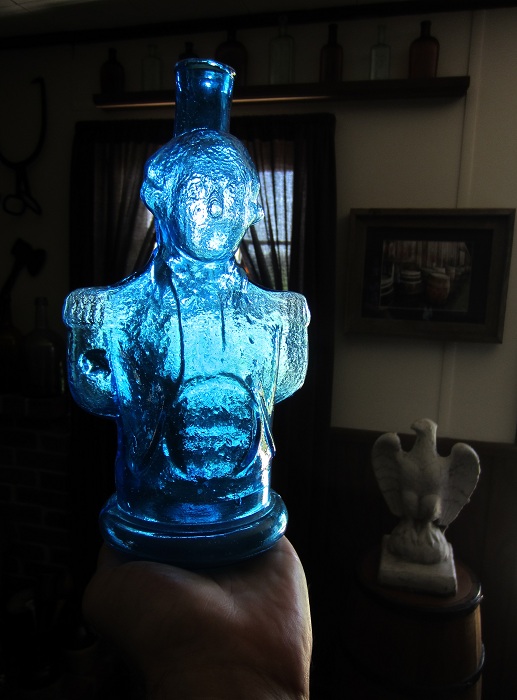I love Shupp’s Grove.
Since 1962, from April to October, for many a collector, every weekend has been a treasure hunt here.
During season, it’s an outdoor antiques pickers paradise and always will be.
Add a bottle show and it’s fantastic.
The Shupp’s Grove Bottle Fest is my favorite show for so many reasons. First of all, my favorite early Philadelphia glass always makes its way here. It’s also less than 30 miles from me. Even better yet, it’s not in an auditorium, gymnasium, or hotel. There’s no flourescent lighting to try to see what what you’re looking at. There’s only the best lighting of all, natural light, whether direct sun or shade. This relaxing grove of trees is the perfect settting for a bottle show.
Friday
The 2013 Fest was as good as every other year I’ve been here, but even better now, as I’ve met in person many of the glass loving folks who are my online friends on Facebook. It’s more than the glass and its history in this hobby, it’s the great friends you make too.
James Becker from upstate New York and myself. James is a great friend and also a wealth of knowledge, having collected historic bottles and flasks for over 40 years. I see him at Shupp’s; we play online and phone bottle, and sometimes I actually teach him a thing or two. I met James last year in a funny way. He was following me around for ten minutes during the show trying to buy a rare embossed Sheets & Duffy quart strap flask that I had just scored from a dealer who didn’t do his research. I knew how good it was before James even had to tell me. That flask, worth 10 times what I paid, is still in my window.
Out for drinks and dinner with Jim Becker and Dana Charlton-Zarro the evening before the show, there’s no telling who you’ll run into.
Dana took this picture of me mixing it up with some of the best bottle folks I’ve had the pleasure to meet. Richard ‘Dick’ Watson is to my right, he wrote the book “Bitters Bottles” in 1965, the year I was born. Last year at Shupp’s I acquired a beauty of an 1840’s Philadelphia historic flask from him. Just above Dick is David Olson, a great guy and a very serious bottle dealer and collector I met on Facebook and whom I now met in person. There’s some serious antique glass knowledge in these four heads. I may be the youngest, but I catch up pretty quick. It was a fun and excitable evening. However I made it an early one and was at the show at 5 AM.
Saturday
I did go around first and make a few acquisitions. As I did, I decided to take some pictures to show the atmosphere. To illustrate why Shupp’s Grove is the perfect place for a bottle show. Below is a photo gallery of what caught my eye just strolling the show in this beautiful setting.
Demijohns for my friend Dale Santos, the California King of Demijohn collectors.
Various labeled bottles for my New York labeled bottle collector friend John Panella.
A colorful variety including some pretty poison bottles that caught my eye.
A beautifully “Sick” soda that I thought was stunning. For those not familiar, what is happening here is the glass is actually decomposing and flaking back into silica. Compared to the plastic bottles we use now, which will sit in the ground for 1000 years or more, a glass bottle is actually biodegradeable.
Here’s a grouping of goodies, an amber USA Hospital, a cobalt Caspers Whiskey, a Pineapple figural Bitters, a Browns Indian Queen figural bitters, a National Ear of Corn figural Bitters and a very unusual Saratoga bottle, a type I’ve never seen before with a unusual wide tooled mouth.
This is interesting to see a grouping of woven wrapped bottles, usually referred to as wicker wrapped.
I love the figural pig bitters. This Berkshire Bitters is not as often seen as the Suffolk Bitters pig from Boston. This is a bit more rare and is from Cincinatti, Ohio. Note the price, this piece is quite the investment. In the latter third of the 19th Century a pig represented prosperity, maybe it’s where the old saying comes from: “Living high on the hog.”
Serious Apothecary bottles can come in some stunning colors with labels under glass. The bright green ones have uranium oxide in the glass mix, causing them to glow under a blacklight. This is usually referred to as ‘Vaseline Glass’ by collectors. Below is the only vaseline glass insulator I’ve ever seen. Although not old, I think I recall seeing a 1972 date on it. Likely made as a commemorative, it’s still a stunning insulator.
Speaking of Insulators, here’s what looks to be a mile long table of beauties:
Below are some fabulous Dr. Townsend’s Sarsaparilla bottles from Albany, New York. Featuring both color and crudity, these date to the mid 1800’s.
If you like early to mid 20th Century Soda Bottles, you could spend some time having a look at all these and note how they all seem to want to jump out at you:
There’s one set of tables that’s there every year, and I never miss having a ‘pickers’ look see. I always find something interesting at this “pickers dream table,” as you’ll see. It’s quite a collage of everything.
The Dealers and Friends in the Antique Bottle World
I had arrived before most dealers had either set up, or untarped their tables, some having set up Friday night and literally camped next to their set up. I didn’t want to miss a thing. I looked for familiar faces and saw Danielle Kreeger, my favorite Philadelphia dealer. She’s a bottle digger and dealer extraordinaire. Up and at it in the morning sunlight, this bottle Gal has amazing examples of East Coast, Philly, and all types of bottles to suit every collectors tastes. Last year I acquired my favorite 1850’s Union Glass Works teal soda from Danielle. She has her own website: www.bottleland.com and be sure to check it out. There’s no telling what she’ll come up with and her prices can’t be beat.
A very attractive set up and dealer. For Dyottville or Union Glass Works bottles, I never miss checking out Danielle’s tables.
I was looking for another Union Glass Works bottle, but they can be rare and I don’t remember seeing a single one at the show this year. Danielle sure had everything else though.
Moving on, it was time to go see who else had what. I encountered the table of Jack Pellitier. (It’s very hard to miss.) Jack has some of the most amazing historic flasks. Although most are New England in origin, I sometimes see a Philly flask amongst the mix. Walking up to his tables I ran right into my friends Dana Charlton-Zarro and James Becker. Dana’s dog, Annie, is a beautiful ‘Potcake’ from the Bahamas. I never met such a beautiful, well behaved, and sweetheart of a dog. Annie wins Best of Show for Bottle Dog.
Below is Dana with Jack Pellitier. He’s a great guy and his selection of historic flasks and bottles are fantastic.
Looking at Jack’s table was mesmerizing. I wanted quite a few examples he had, but it was like being a kid in a candy store, it was hard to choose.
The color of some of these mid 1800’s figural barrel Bitters are hard to even find words for. What is the color of the first barrel on the right? “Smokey Gasoline Apricot?” Whatever is it is, it’s a beauty and a color I see only on these barrel types.
Shown below, this beauty of an early 1800’s midwestern Molasses Amber colored Pitkin Flask caught my eye.
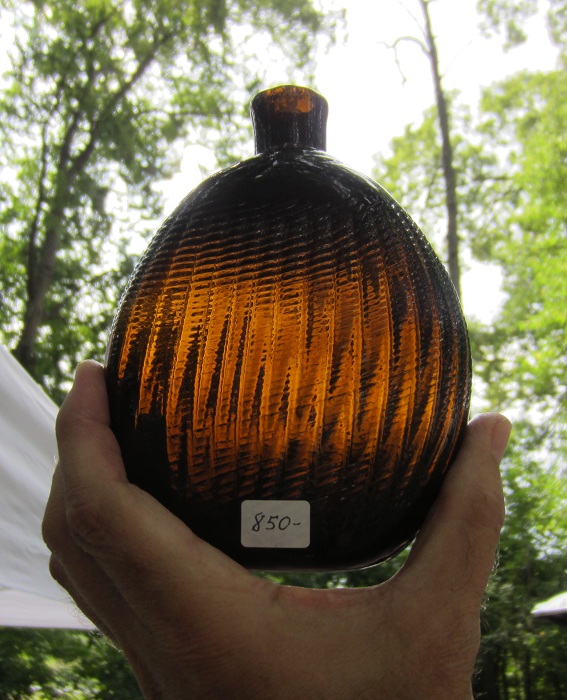
But my personal favorite of Jack’s was this Forest Green Pittsburgh Double Eagle in quart size shown below. The color is amazing.
I have this identical flask in Glacier Aqua Blue which is the norm for 19th Century Pittsburgh area glass; this green in a Pittsburgh example is very seldom seen. A rare color makes this historic flask very valuable. I thought about buying this, but wanted to see what Philadelphia examples I could find first.
Dana led me to David Olson’s tables where he had an amazing selection of all types of antique bottles and historic flasks.
Dana with David holding a large 1800’s “Cathedral” Pickle Jar. Below are some very pretty soda and squat bottles that Dave also had.
Next it was on to Bob Barenski’s table, where I saw some very serious antique glass and met a another online friend in person.
Left to right is Rick Meech Burchfield who takes the time to host and run the Antique Stoneware Collector’s Page on Facebook, Dana Charlton-Zarro, myself, and Bob Barenski.
Passing by Dick Watson’s table, I noticed the legendary Historian for the Federation of Historical Bottle Collectors was counting money. I jokingly asked if he was gonna retire on that. He laughed and held it up and I caught the picture.
Later on, Dana caught myself, Dick, and Dave Olson chatting and snapped a picture:
I happened across the table of Jim Bender, the Membership Director for the Federation of Historic Bottle Collectors.
After chatting it up with Jim, I was walking away and heard someone say,
“There’s the ‘Phantom Digger.'”
I turned to see a young man packing the trunk of his old classic car and I remembered looking at a bottle at his table. He had come in, set up and had sold out in a couple of hours. He seemed to know exactly what he’s doing, as he made his sales and left. I caught a couple of surrupticious zoom in photos of him packing up to add to the mystery. I remember him being very personable to talk to.
Next year I’ll buy the bottle I liked at his table as it didn’t stay long, nor did he.
Next, I found my self at John Pastor’s display. He owns a very fine glass auction, http://www.americanglassgallery.com/ and publishes one of the best antique bottle magazines.
Due to my excitement over a very historic bottle on his table, I never did get a photograph of him. (Just the top of his head seen above.) The bottle on the left of the center three had caught my attention. It’s a Casper Wistar, United Glass Works Wistarburgh, and dates back to the 1750’s. These are not easy bottles to find and Wistarburgh was founded in 1738 and was the first successful glassworks in the Colonial Period. Located near Alloway, New Jersey, this glass works made special glass items for Benjamin Franklin for his experiments.
I noted this freeblown beauty did have a flaw, or, as I would call it, ‘Character’ when it’s this old. It was perfect save for a 2 inch flash crack line on the side 3:00 position. Usually a $1500 or more bottle without the flaw, John was selling this one for only $95.00. I couldn’t believe it had sat there all morning. What a piece of history. Most collectors, (including myself) are concerned about condition, but this Wistarburgh bottle was over 250 years old. Despite the line on the side of it, it displayed beautifully and into my hand it went. The icing on the cake was John volunteering to take only $75.00 for it.
A beautiful historic glass bottle, flaw or not, I love it. Never get too picky; you’ll miss out on good things. Lose the 20x jewelers loop and the electron microscope if you collect 250 year old glass.
He also had noted my previous writings and gave me a free issue of his magazine:
He mentioned he could use an article and I’ll be happy to oblige him.
A Special Thank You
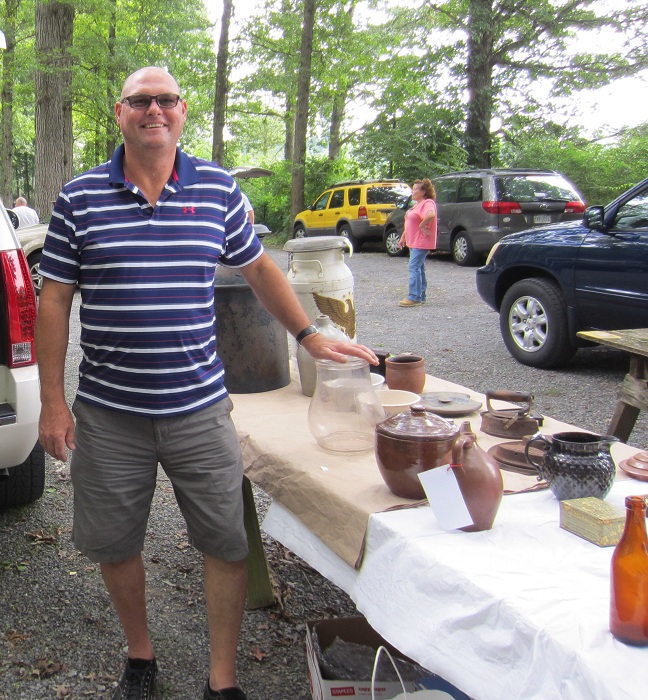 To show sponser Steve Guion for keeping the Shupp’s Grove Bottle Fest going for many years. Thanks Steve.
To show sponser Steve Guion for keeping the Shupp’s Grove Bottle Fest going for many years. Thanks Steve.
Steve wrote me after reading this:
Hey thanks DUDE! This was a SELLOUT this yr.
140+ dealers.
Almost 500 tables!
Great Weather!
Great Friends!
What more can be said!
The Acquisitions
I had come across a Philadelphia whiskey ewer I couldn’t believe. I haggled a bit and acquired it for a very reasonable price. I was so excited about it, I didn’t photograph it until I got it home. It’s a Charles Wharton 1850 Chestnut Grove Whiskey ewer with tooled pouring spout and applied handle. A cork originally went into the top. Located at 116 Walnut Street in Philadelphia, Charles Wharton was just two doors down from the famous E. G. Booz, maker of the famous cabin whiskey at 120 Walnut street. I wonder if they were friends or fierce competitors. I already have two of the standard Wharton Chestnut Flasks in different tones of amber and I knew this would make a beautiful centerpiece, which it does.
Close up of embossing, crudity, and beautiful color:
This piece completes a nice trio in firey Autumn tones:
The 1750’s Wistar Bottle has found a good home and here it will stay.
Note the 250+ years of natural base wear. If only this bottle could talk about everyone who’s ever picked it up and poured or drank from it and set it down.
The top is undeniably Wistarburgh.
Shown below is a ‘Mystery’ Gasoline colored blank square bitters type bottle that features quite overall ‘pinched panels.’
This one is still a mystery to me and even bitters expert Dick Watson, who did state he thinks it’s definitely American. It appears to date to the 1860-70 period. The base is most unusual.
The color is amazing with Gasoline and Apricot tones.
The bottle from the previously mentioned ‘Pickers Dream Table’ turned out to be the most screaming blue Clevenger Washington figural bottles I’ve ever seen. I have seen hundreds of these in various colors, but never one like this. Clevenger bottles have become collectible in their own right, having been made from the 1930’s through the early 1960’s. I love this one.
Shupp’s Grove Bottle Fest 2013. Was it a good show?
Yes.
It always is.



